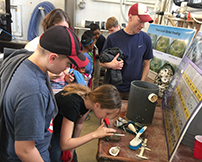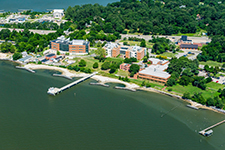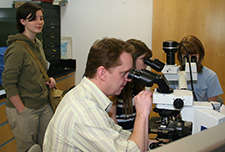Join us for an Oyster Tour! The Virginia Institute of Marine Science (VIMS) offers tours for preformed groups such as civic clubs, community organizations, and middle- and high-school students year-round and public tours for non-groups during the summer months.
Schedule your visit soon to see how scientists use CSI techniques to understand clam and oyster diseases in the Shellfish Pathology Lab; watch live animals in VIMS Visitors Center and hear about related research; and tour the Oyster Hatchery to learn about the breeding and feeding of oyster brood stock. Reservations required. Check www.vims.edu/public for more information or give us a call at 804.684.7061.
Phone
804-684-7061
Website
Address
1375 Greate Rd
Gloucester Point, VA 23062
Hours
Monday - Friday 9 am - 5 pm


Join us for an Oyster Tour! The Virginia Institute of Marine Science (VIMS) offers tours for preformed groups such as civic clubs, community organizations, and middle- and high-school students year-round and public tours for non-groups during the summer months.
Schedule your visit soon to see how scientists use CSI techniques to understand clam and oyster diseases in the Shellfish Pathology Lab; watch live animals in VIMS Visitors Center and hear about related research; and tour the Oyster Hatchery to learn about the breeding and feeding of oyster brood stock. Reservations required. Check www.vims.edu/public for more information or give us a call at 804.684.7061.
The Virginia Institute of Marine Science (VIMS) has a three-part mission to conduct research in coastal ocean and estuarine science, educate students and citizens, and provide advisory service to policy makers, industry, and the public. VIMS provides these services to Virginia, the nation, and the world.
As one of the largest marine-science centers in the U.S., VIMS maintains a comprehensive suite of research laboratories, provisioned with the analytical instruments and cutting-edge field equipment needed to address the challenges facing Chesapeake Bay and the coastal ocean. Our buildings and people support advanced research in areas such as computer modeling, genetics, geochemistry, immunology, pathobiology, physical oceanography, and toxicology.
Oysters @ VIMS
Field and laboratory research at VIMS is key to the recent surge in oyster aquaculture in Virginia, and also underlies increasing success in restoring wild populations of the Eastern oyster Crassostrea virginica to Chesapeake Bay. Oysters were historically one of the Bay’s keystone species, filtering water and providing habitat for numerous Bay organisms through their reefs. Oyster restoration aims to reclaim some of these benefits.
Aquaculture Genetics & Breeding Technology
The scientists of the Aquaculture Genetics and Breeding Technology Center (ABC) at VIMS use a combination of selective breeding and genetic research to domesticate the native Eastern oyster for aquaculture. C. virginica is important both commercially and ecologically in Chesapeake Bay. ABC’s goal is to help revitalize the economic value of oysters in the Bay, and to improve their value for farming to help the aquaculture industry meet humanity’s growing appetite for seafood. The focus of ABC’s efforts is to provide genetically superior brood stock to industry. Initial efforts emphasized development of disease-tolerant strains of C. virginica, whose population in Chesapeake Bay has been devastated by the diseases MSX and Dermo. Current efforts continue this work but also emphasize improvement of other production traits, such as growth and meat yield. Knowledge of oyster genetics also sheds light on the genetics of other shellfish.
Molluscan Ecology
The Molluscan Ecology Program at VIMS is a dynamic research group that derives its origins from the original oyster biologists at the Virginia Fisheries Laboratory, the organizational ancestor to VIMS. As the oyster aquaculture industry expands, this program works with local industry members investigating various aspects of water quality and sediment deposition associated with oyster aquaculture, working toward the development of a Best Management Practice (BMP) plan.
Marine & Aquaculture Molecular Genetics
The Marine & Aquaculture Molecular Genetics laboratory develops and utilizes molecular genetic markers for aquaculture species including the eastern oyster. The molecular markers are being used for population genetic analyses, genetic tracking of oyster restoration efforts with hatchery-reared stocks, and examination of the genetic interactions between hatchery stocks and wild populations. Additionally, these markers provide genetic maps and information to facilitate breeding programs.
This laboratory also develops molecular diagnostics for harmful algal bloom (HAB) organisms and human pathogens, to detect HABs and pathogen species in finfish, shellfish, and environmental water and sediment samples.
Shellfish Pathology
The VIMS Shellfish Pathology Laboratory studies the diseases of commercially important mollusks like oysters and clams. Diseases such as Dermo and MSX in oysters, and QPX in clams, continue to impact fisheries and aquaculture industries for these species. The laboratory has a long-standing advisory mandate to provide guidance concerning these diseases to the Virginia Marine Resources Commission. The Shellfish Pathology Laboratory also plays a prominent international role in shellfish health management as the World Organization for Animal Health Reference Laboratory for haplosporidiosis (a category of disease including MSX) and perkinsosis (which includes Dermo). Development and evaluation of diagnostic assays for these diseases, and training of students and researchers from around the world in these methods, have been activities central to this role.
Virginia Sea Grant Marine Extension Program
The Oyster Aquaculture Extension Agent acts as the bridge between aquaculture researchers and the commercial growers, harvesters, and hatcheries, and works with commercial aquaculturists and state agencies to educate the public about aquaculture in the area. The extension agent also works with scientists to develop research related to water quality and other local concerns.
My Events
USE THIS SECTION TO DISPLAY COMPANY'S EVENTS

